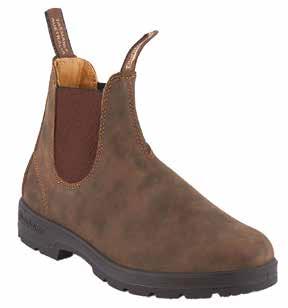BROADMEADOWS • SOUTH NORMANTON BLACKWELL • NEWTON • HILCOTE
12 EDITIONS READ BY OVER 162,000 RESIDENTS
25TH AUGUST 1919
World’s first international daily air service begins between London and Paris.



BROADMEADOWS • SOUTH NORMANTON BLACKWELL • NEWTON • HILCOTE
12 EDITIONS READ BY OVER 162,000 RESIDENTS
25TH AUGUST 1919
World’s first international daily air service begins between London and Paris.


So now I’m just starting to think I’m a little bit psychic about the weather (or I’m Storm from X-Men) as last month I said, and I quote; “I just pray for rain”. If ever there was a lesson in being careful regarding what you wish for!! At the time of writing, we are a week away from the Y Not festival and as such, I am whole heartedly, categorically NOT praying for rain. I am a fair weathered camper/ festival go-er and as such, some nice warming sunshine has been requested.

Although one thing I am grateful for regarding the copious amounts of rain – the blasted midgies have gone to ground again! I had a bit of a nasty bite from one of them – obvs left it for a while (like 10days or so, probs shouldn’t have) until needing a killer dose of antibiotics. I wasn’t too worried until the Nurse Practitioner looked at it and went “Oooh, yep, antibiotics and if you don’t see significant improvement in the next 48hrs, get yourself down to A&E”. I said – “OK, what for?” (somewhat naively) and she said, “because you will need antibiotics intravenously by then if the tablets aren’t working”. No panic then #eyeroll. Anyway, a bit of googling and several panic attacks later, it’s all good thankfully.
Another month, another World Cup – Nope not the Football, this time it’s Netballs turn
and it is showing on the Beeb! As an avid fan and (fairweather) player, that’s me sorted for entertainment!
Speaking of entertainment, whilst most people were choosing between Barbie and Oppenheimer this month #Barbenheimer, we ended up at Elemental courtesy of our eldest Niece’s birthday. I can’t say I identified with the story of a fiery tempered young woman but I am now tempted to change my purple hair to red! Workwise, we’ve created a lovely high street feature in the Matlock & Darley Dale magazines. Honestly, it is such a glorious place to go to and the high street is so beautiful with lots of varied shops – they deserve lots of support to keep them thriving. Our next features are scheduled for Christmas…… sorry to mention it but it is coming around quickly!! That is assuming we can get some people to fill our Sales Vacancies – why wouldn’t you want to work here if you have experience in business-to-business sales?!


August is traditionally holiday time here in the UK, schools are closed, the weather is (hopefully) behaving itself, and Autumn still seems a while away, but what else is the month known for?
Here are a few fun (and not so fun) facts I discovered:
➤ August 1st is Lammas Day; this marked the start of the harvest season during the Anglo Saxon period. The name derives from an Anglo Saxon word - hlāfmæsse - meaning “loaf mass”. Bread was made from the first wheat harvest and blessed before being broken (not cut) into four pieces and buried in each corner of a barn that would be used to store the full harvest. Another loaf would be shared amongst loved ones. Both rituals were thought to protect the upcoming harvest.
➤ In the Roman calendar, August was first known as “Sextilis” - the Latin word for six - as until around 700 BC only ten months were counted. When an extra two months were added, Sextilis was bumped to the eighth month. The name August was not adopted until 8 BC, when it was renamed in honour of Emperor Augustus.
➤ In a non-leap year, August will not share its starting day with any other month. Of course I had to check! This year August 1st will fall on a Tuesday; of the other eleven months of the year, three start on a Wednesday, two on a Sunday, two on a Saturday, two on a Friday, one on a Thursday and one on a Monday. So it appears to be true - but as two other months this year also fall into this solo category, I’m not sure it is such a startling fact.
➤ The Earl of Sandwich “invented” the first sarnie in August 1762 and picnics have never been the same since. To be honest, I’ve always found this “fact” hard to believe - I mean, he couldn’t have been the first person in history to stick a bit of meat between two slices of bread.
➤ August is also the month of…Weeds! In the days of the Anglo-Saxons, August was known as “Weod Monath” or Weed Month, because it was when weeds and plants grew the fastest.
➤ August 26th, 1936, saw the BBC transmit its first high-definition television pictures.
➤ Martin Luther King delivered his famous “I have a dream speech”, August 28th, 1963.
➤ On August 24th, 79 AD, Mount Vesuvius erupted, destroying the cities of Pompeii and Herculaneum. One thousand eight hundred and sixty six years later, on August 6th, 1945, the US dropped atomic bombs on Nagasaki and Hiroshima.
➤ August 13th, 1964, Britain carried out the last two executions before capital punishment was abolished.
➤ August 16th, 1977, Elvis Presley packed up his blue suede shoes and left the world behind.
➤ Princess Diana died in a car accident in Paris on August 31st, 1997.
Whatever you do this August have fun and remember that we could have been stuck with a month named Sextilis - imagine the innuendos!


We aim to help amputees, their families and friends to adjust to the loss of limbs. We aim to help our members to meet up and support each other and also to provide social and educational activities.
THE SERVICES WE OFFER:
• We work in partnership to promote independence
• Support service – supporting people
• Promoting independence, confidentiality, rights, equal opportunities
• Review services
• Liaise with family, other agencies, older people, young people, people with a disability


• Improve quality of life
• Provide opportunities for involvement and access to activities
• newsletters
• monthly meetings
















The year 1841 will ever be associated in the English mining industry. The year evidence was collected relating to the employment of children in the coal mining industry. It is, also significant for the introduction of the statutory reporting of all fatalities occurring in the industry.



It soon became apparent that although fatalities associated with shaft accidents were rare, when they did occur, multiple people were killed.
Unbelievably, because the job of operating the steam winding engine was not considered to be an arduous job, boys in their early teens were often employed to act as ‘winder’.
The revelation that many miners were being killed in shaft accidents resulted in a fresh look at the situation. One of the initiatives resulted in seeking a way of ensuring lives were not lost, if and when the cage was overwound and went over the headstocks.
Enter one John King, a resident of Pinxton John was born in the Loscoe, Heanor area and initially worked as a mechanic in the hosiery industry; he was an inventor and invented a railway signalling system which brought him to Pinxton, a recognised railway centre.
He then set about obviating the tragic loss of life through coal mine shaft overwinds. He was not the only one. At least four others were also concentrating their efforts on the same task.
In the 1880’s The Institute of Mechanical Engineers tested each of the five devices in use. Of the five categories King was best in four and second best in the other.
The main criteria were ‘certainty to work’ and simplicity of operation (less risk of failure).
John King’s invention has never been bettered. Today it is in use in well over 50% of all the world’s deep mines.
Today, the patent is owned by Bellambie Mining of South Africa.
Now comes a co-incidence which is so improbable, it is difficult to believe, but nevertheless, true. Several years ago, the author met the Chief Engineer of that company. He was born in Pinxton, in the Old Post Office which once stood on the exact spot on which the memorial to John King now stands.
The author of this article had the honour and privilege of officially unveiling the memorial.
The Society meets on the third Monday, monthly at The Post Mill Centre at 7pm. Visitors welcome.





Fill in all the numbers!
This is a sudoku 1 square grid

81 cells
9 3x3 blocks
1 simple rule: Use all the numbers 1-9, with no duplicates allowed, in any row, column, or block.
This puzzles has been devised by the brilliant Professor Rebus. For more of his puzzles visit www.pitcherwits.co.uk





A completely professional 24 hour service, covering all areas


Private Chapel of Rest in peaceful surroundings
We will provide you with a personal and sympathetic service, looking after all your needs and wishes


Pre-arranged Funeral Plans, tailored to your specific wishes, are available

Year 1560. Italy. 15-year-old Lucrezia di Cosimo de’ Medici leaves the safety of her family home in Florence to begin arranged married life with Alfonso, Duke of Ferrara. Within a year, she was dead. The rumour was that her husband killed her.
The Italian Renaissance was a time of treachery, plot, power and sumptuous luxury. It was a dangerous time to be alive, but it was especially precarious for women, effectively held captive by their families and by outside society with little hope of release or rebellion. Their lives were largely lived in the shadow of the men at their side.
Maggie O’Farrell’s novel The Marriage Portrait is based in history. She uses historical fact and real characters from the period so finely that you feel totally enveloped and transported to the time and place.
The book is a delight, detailed and compelling – and such a page turner. Lucrezia may be trapped in this world, but she leaps out into your head through this book. A real treat if you like to be captivated by your reading matter.



The MPC Services team are here to help make sure that your sewage system is working well, properly maintained, up to date with the latest compliance regulations, working quietly and energy efficient. *Energy saving based on simply changing your traditional 85W air blower for a modern efficient FujiMAC 47W Japanese one, with electricity at 55p/kWh, for no loss of performance. Additional efficiency savings are typically possible.















Method:
1. Spray a large non-stick pan with low-calorie cooking spray and place over a high heat. Add the chicken, peppers and onion and stir-fry for 5-7 minutes, or until lightly browned.
2. Add the diet cola, stock, passata, tomato purée, garlic, Worcestershire sauce, soy sauce and herbs and stir well. Bring to
This is a true Slimming World Classic and for good reason. Packed full of flavour that will have you going back for more!
the boil, cover, reduce the heat to mediumlow and simmer for 12-15 minutes.
3. Add the sugar snap peas, stir and increase the heat to mediumhigh. Cook for another 10-15 minutes, or until the chicken is cooked through and the veg is tender.

Ingredients:
• Low-calorie cooking spray
• 4 skinless and boneless chicken breasts, cut into bite-sized chunks
• 1 red, 1 yellow and 1 green pepper, cut into bite-sized chunks
• 1 onion, finely chopped
• 330ml can diet cola

• 200ml hot chicken stock
• 8 tbsp passata with onions and garlic
• 4 tbsp tomato purée
• 2 garlic cloves, finely chopped
• 2 tsp gluten-free Worcestershire sauce



• 1 tbsp dark soy sauce/tamari
• 1 tsp dried mixed herbs
• 200g sugar snap peas

































Some of the recent items we have acquired for our reminiscence sessions are a box of Carmen heated rollers with pins and a vanity set for a dressing table (a long-handled mirror and brush set). This has started me thinking about what my own mum held dear.

Although she had no time to sit and preen at the dressing table, my mother always found a small space where she could lay out some special items. Her vanity set had been a gift to her on her 21st birthday, it included a hand-held mirror with a matching brush and comb.

She owned a wooden, shell-encrusted jewellery box containing her earrings: clip-ons or screw-back type were the fashion then. Her beads, necklaces and paste pearls were laid out on a tray, with the longer strings hooked onto the side of the mirror. The tray also held a variety of trinkumtranks like odd buttons, curtain hooks, pins, coins, dry-cleaning tickets, hairpins and hairnets.
A lidded glass pot contained scented talcum powder and a soft puff for dusting after a bath. She also always had a pot of
Pond’s vanishing cream at hand and was never seen without lipstick.
A bottle of Tweed perfume and Avon “Sweet Honesty” stood together with a small flask of 4711.
At the back of the table was a spray bottle of hair lacquer and, later, a set of Carmen heated rollers and a bonnet hairdryer.
Some items came and went as the years passed but the object she treasured most on her dressing table, was an aged photograph of her own mum and dad.


I do hope you have memories of a dressing table that belonged to someone special in your life.
Janet and Paul Barrass are All Around the Shire. Find us on or email: oldfield512@btinternet.com for more information.




















We have been saving this walk for a nice summers day and luckily for us we chanced upon one, not least because the heavens opened not long after we got back to the car!
Rafa has now fully retired from the rambles. At 14 years (98 in dog years!) it is just proving too much for him. So Flake has taken on full responsibilities. Rafa has been teaching him all the important stuff, like how to pose for a nice picture, which way up to hold the map and which pockets Mum keeps the treats in. So, we will need a new name for the walks... any suggestions gratefully received!


A medium length walk which should take you and your dog around 3 hours to complete. There are a few short sections of road so please take care. Most of the walk is on paths and trails but please wear appropriate footwear and please follow the countryside code.
START: CHURCH OF ST. MICHAEL, CHURCH LA. PLEASLEY , MANSFIELD, NOTTS. NG19 7TD.
1. Standing on the road with your back to the church, turn right along the road to the very end. Then take the footpath on the right hand side of the road and follow it uphill and round to the left. Where the path splits take the right fork and pass beneath a pedestrian flyover.
2. Continue along the path beside a dual carriageway. After a short distance turn left onto a signposted footpath down some steps. At the bottom of the



steps turn right and then after a very short distance at a T junction of paths turn left.
3. Continue to pass through a metal width restrictor and then continue for some distance until reaching a path on your right. Turn right along the path going uphill with a stone wall on your right.
4. At the top of the hill the path joins with another path. Continue straight to pass over a bridge,
past a sign for ‘Mansfield’ on your left and after some distance past a footpath sign on your right. Continue straight and eventually pass underneath a stone arch bridge and then further on pass by a metal gate. After a short distance you will reach a road. Turn left along the road.
5. Continue along the road until reaching some houses on your left. At this point turn right along a single track road signposted for ‘St. Chad’s Church’. When you reach the church on your right continue straight ahead to cross over a metal stile onto a signposted footpath. Continue straight keeping a river over to your left.
6. After some distance you will reach a T junction with a lane. Turn right along the lane and after a short distance pass underneath a railway bridge. After this follow the lane around to the right and continue along the lane for some distance until passing through a metal gate onto a road.
7. Turn right along the road and after a short distance the road turns into a lane. Continue straight passing a ‘public bridleway’ signpost on your right and then further on pass a ‘public footpath’ signpost on your right.
8. Continue along the footpath and cross over a railway bridge. After cross over a stile and continue with a fence on your left. After crossing a 2nd stile continue until reaching a tarmac lane.
9. Continue straight along the tarmac lane until reaching a road. Cross straight over the road and continue along a single track road. Continue straight to the very end of the road and pass through a metal width restrictor onto a footpath.

10. Continue uphill with a hedge on both sides and then upon reaching a T junction of paths, turn right to pass through a metal gate and cross an open field. At the far side of the field pass through a gap in the hedge to cross another open field. At the far side of this field upon reaching a lane, turn right along the lane and then immediately left to skirt along the edge of a field with a hedge on your left.
11. Continue to a large opening in the hedge on your left. At this point turn left to continue uphill along the edge of a field with a hedge on your right. At the top of the hill pass a yellow marker post on your left and continue to cross another field.

12. At the far side of this field pass a yellow marker post on your right, cross straight over a lane and continue downhill to cross another field.
13. At the far side of the field head into some trees and then down some steps onto a road. Turn right along the road to eventually pass back underneath the pedestrian flyover and follow the path around


This walk is for illustrative purposes only. Voice Magazines Ltd takes no responsibility for anyone who chooses to follow this route and encourages all walkers to obey all byelaws and signs and to respect the area they are walking in, ensuring they pick up all dog mess and obey the countryside code at all times.


















Pitcherwits® are crossword puzzles where some of the clues are in pictures. Sound easy? It’s not called “Pit-your-wits” for nothing! The mixture of cryptic and picture clues, combined with Professor Rebus’ unique sense of humour, will keep you entertained for hours.

Across
8 Link ID to URL in a glaringly vivid way (5)

9 Roast boar in five to make sure it’s well done! (5)
10 Secretory organ is the last in England (5)
12 Composer of velar form (5)

Down
2 The 30cm monarch? (5)
3 Dance the tango in Polynesia (5)
11 Bid farewell to aide, in turnaround (5)
1 Sip merchant’s brew to keep time, squaddy! (5,2,4)

5 Lion is a bit put out by attachment (7)
14 Ignore a difficult time? (4,3)
15 Kit destroyed after rum place for ‘apples and pears’ (5,6)
Down
1 Was dismissive about hog, filmed at odd angle (4,5,2)
4 Polly to fight with a difficult bit of sparkling (4,2,5)
6 Increased, and put on a pair, so to speak (5,2)
7 Brie is a dish for cold place (7)
13 Sweater pattern found in Ken’s CV (1-4) ANSWERS FOR LAST
This puzzles has been devised by the brilliant Professor Rebus. For more of his puzzles visit www.pitcherwits.co.uk

































NEW ROOFS FLAT ROOFS
RUBBER ROOFS ROOF REPAIRS
NEW ROOFS FLAT ROOFS
FASCIAS & SOFFITS DRY VERGE SYSTEMS
RUBBER ROOFS ROOF REPAIRS





CHIMNEYS GUTTERS & DOWNPIPES
FASCIAS & SOFFITS DRY VERGE SYSTEMS
RIDGE TILES CLADDING
CHIMNEYS GUTTERS & DOWNPIPES
















RIDGE TILES CLADDING

No deposit required
GUARANTEED!
ALL WORK IS GUARANTEED!
No payment un�l work finished & sa�sfied
No deposit required
Local family run business & fully insured
No payment un�l work finished & sa�sfied
References available
Local family run business & fully insured
References available
We guarantee to beat any wri�en quote
We guarantee to beat any wri�en quote





Please call FREEPHONE 0800 747 1902 or 01623 859932 for a no obliga�on quote
Please call FREEPHONE 0800 747 1902 or 01623 859932 for a no obliga�on quote



for a FREE no obligation quote


Unit F2, Concept 360, Chadburn House, Weighbridge Road, Mansfield. NG18 1AH
Unit F2, Concept 360, Chadburn House, Weighbridge Road, Mansfield. NG18 1AH















































Mike is back with a tall tale and a punchline that will have you wincing! Enjoy!
Mike is always glad to hear from you at : mike.musings@outlook.com
(After the Roger Rabbit tale from a few months ago, the feedback I got was………… can we have more please? Well, try these out!”)
A group of four-year-olds were trying very hard to become accustomed to school.
The biggest hurdle they faced was the teacher insisting that they were now old enough to stop using babyish language.
She was constantly asking them to use ‘big people’ words, just like Mum & Dad. An example of this came on the Monday that she asked the class what they had been doing over the weekend.
“Kayleigh,” she asked, “What did you do?”
When the little girl replied that she’d been to see Nana & Pops, the teacher suggested that a more grown-up way would be to say ‘GRANDPARENTS’.
When Ryker then said that he’d gone to Matlock and had a ride on the choo-choo, he was mildly admonished and told that it would be much better for him to say that he’d been on a ‘STEAM TRAIN’.
The teacher than asked Carson what he’d been doing and was pleasantly surprised, but pleased, when he said he’d been reading a book.
“That’s wonderful,” the teacher responded smiling, “and what book have you been reading?”
Carson, not used to such praise, puffed out his chest and proudly replied, “Miss, it was Winnie the S**t.”
A woman I know recently accompanied her husband to the surgery. He’d been having a few health problems, and after his check-up, the GP called the wife into his office alone.
He asked her to sit down as she had some disturbing news to impart. “Your husband,” he began, “is suffering from an extremely rare and severe disease. This combined with a high level of understandable stress is such that if you don’t follow my advice, he is likely to die in the very near future.”
“Each morning, you must fix him a healthy breakfast and be especially pleasant as it’s vital that he stay in a good mood.”
“For lunch, I’d suggest that you make him a nutritious meal, and for tea, something special, that you know he’ll enjoy.”
“You mustn’t burden him with any chores as this could exacerbate his condition and it’s important that you never discuss your problems with him as the added stress that this will undoubtedly cause, may prove fatal.”
“Finally, and this is important, as part of a planned recovery therapeutic programme, you must allow him to actively pursue his conjugal rights, without developing a headache or the like, whenever he feels the need.”
“If you can do this for the next ten months or so, it is likely that your husband will make a full recovery.” At this, the doctor wished her good luck before opening the door to reunite with her husband waiting patiently outside.
On the way home, the husband broke the eerie silence by asking, “You were in there quite some time. What did the doctor say?”
“You’re going to die,” was the speedy response.

























They can encourage blanket and pond weed and blue green algae which can be dangerous for dogs and cause rashes to humans. You’ll know it’s blue green algae if you swirl a stick in the water and it comes out like blue green paint. However bubble fountains such as the little solar ones available in most garden centres help keep a pond healthy. Removing weed with a stick or net will improve its overall health, but leave the weed on the side of the pond overnight to allow any critters to crawl out.

Keeping a decent shape to your lavender for next year needs action once the flowers have gone over – usually around August. Lavenders tend to look straggly if left to their own devices. When trimming don’t cut back into old wood as this may inhibit growth. Cut back to green stem and this will allow an inch or two of growth before winter putting it in a good condition for spring. Prune your blackcurrant and summer fruiting raspberries once they’ve finished fruiting. Cut back this year’s fruited canes and stems and leave the green canes for next year. If you’ve got a glut – what a wonderful thought, having a glut of rasps ! – freeze them on trays and bag for winter glee.





Top tip: Take cuttings of fuchsia, geraniums and pelargoniums for more plants net year. They’ll root easily now. Cut a healthy stem below a leaf node, make the cutting about 3 inches long, take leaves off apart from a few at the top. You can use rooting powder but they’ll probably be okay without. Plant round the edge of a plant pot in a perlite/compost mix and they should be away in no time. Take indoors or keep in a frost free space over winter.

The warm humid conditions of summer are good for many parts of the garden but may not be so healthy for

The word ‘bog’ doesn’t necessarily conjure up a positive image; in fact, it is downright negative. And yet the peatlands of the Peak are proving vital for our battle against changing climate and in holding back floodwaters through ‘slowing the flow’ when rivers are swollen after storm events. At the head of each main river catchment, the peat-bogs hold back vast quantities of water which are then released over time and alleviate potential droughts downstream. The bog moss alone holds about twenty times its own weight in water. What is more, the peatlands are wonderfully rich biodiversity sites too with unique species of plants, animals, and fungi. However, there is bad news because for over two hundred years people have drained and burned the peatlands, and our atmospheric pollution has killed off the vital sphagnum mosses which when healthy hold the water, provide habitat for rare species, and remarkably too, capture carbon that is laid down as peat. Two centuries of over-grazing by sheep has also done for the peat bogs and this reached its nadir in the late twentieth century. All in all, this is bad news, and a major cause of a collapse of what we now call ‘ecosystem services’ like floodwater control and carbon capture.
But there is good news today because with reduced sheep numbers, lowered air pollution, and some tender loving care, our bogs are bouncing back to life. Some of this is due to major investment in projects to block drains, alleviate soil acidity, and even to

re-seed sphagnum mosses back into the degraded peat landscapes. However, for me even more exciting, is the ability of nature to heal itself. My colleagues and I have been monitoring sphagnum mosses and rare flowers on Ringinglow Bog near Sheffield. It is doing what I call ‘self-rewilding’ as the peat-building bog mosses are returning with ten or more species now recorded in what was described as a ‘sphagnum desert’ back in the 1980s. This is in an area where there has been no artificial introduction of sphagnum, but nature has been left to repair itself.




Furthermore, the flowering plants of moorland and peat bog are also returning. The bog mosses are now joined by the elusive bog rosemary or ‘Andromeda’ which has returned in abundance. Last recorded in the 1960s and 1970s before the North Sea Gas pipeline cut a deep trench though both moor and bog, this plant has made a remarkable and unexpected recovery. Sundew is reappearing in its old haunts, along with one of my favourites, the diminutive upland lily, bog asphodel, and the archetypical flowers of wet bogs, the cranberry, and the cross-leaved heath. Not far away, the once extinct royal fern has reappeared and joins several other upland wet bog ferns such as hard fern, lemon-scented fern, and narrow buckler-fern.
As the bogs recover then so do associated wildlife species such as the upland dragonflies, goldenringed and black darter, and of course that often unnoticed denizen of upland bogs, the water vole. Golden plover, dunlin, and curlew are birds that also depend on these wetlands for their survival. Each visit holds the hope of the re-discovery of a precious species once thought lost forever.




















